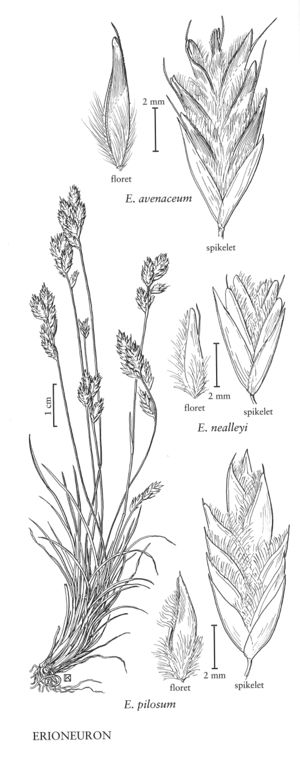Difference between revisions of "Erioneuron pilosum"
FNA>Volume Importer |
imported>Volume Importer |
||
| Line 47: | Line 47: | ||
|publication year= | |publication year= | ||
|special status= | |special status= | ||
| − | |source xml=https:// | + | |source xml=https://bibilujan@bitbucket.org/aafc-mbb/fna-data-curation.git/src/bb6b7e3a7de7d3b7888a1ad48c7fd8f5c722d8d6/coarse_grained_fna_xml/V25/V25_70.xml |
|subfamily=Poaceae subfam. Chloridoideae | |subfamily=Poaceae subfam. Chloridoideae | ||
|tribe=Poaceae tribe Cynodonteae | |tribe=Poaceae tribe Cynodonteae | ||
Revision as of 22:04, 27 May 2020
Culms (6)10-30(40) cm tall, (0.3)0.6-1(2.5) mm thick, glabrous or hispidulous. Ligules 2-3.5 mm; blades (1)3-6(9) cm long, (0.5)1-1.5(2.5) mm wide, both surfaces sparsely pilose or glabrous, grayish-green. Panicles 1-4(6) cm; branches with 3-9 shortly pedicellate spikelets. Spikelets 6-12(15) mm, with (5)6-12(20) florets. Glumes exceeded by the lowest florets, pale; lower glumes 4-7 mm; upper glumes 4-7 mm; lemmas 3-6 mm, green or purplish-green when young, becoming stramineous at maturity, awned, awns 0.5-2.5 mm, apices acute, entire or bidentate, teeth 0.3-0.5 mm; anthers usually 3, 0.3-1 mm. Caryopses 1-1.5 mm. 2n = 16.
Distribution
Kans., Okla., Colo., N.Mex., Tex., Utah, Calif., Ariz., Nev.
Discussion
Erioneuron pilosum grows on dry, rocky hills and mesas, often in oak and pinyon-juniper woodlands. In North America, it is represented by E. pilosum var. pilosum. This variety differs from the other two varieties, both of which are restricted to Argentina, in its longer, less equal glumes and shorter awns.
Selected References
None.
